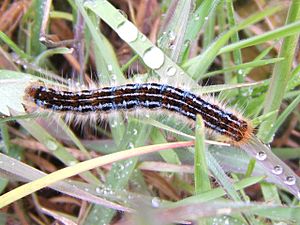Alpine ring moth
| Alpine ring moth | ||||||||||||
|---|---|---|---|---|---|---|---|---|---|---|---|---|

Malacosoma alpicola caterpillar |
||||||||||||
| Systematics | ||||||||||||
|
||||||||||||
| Scientific name | ||||||||||||
| Malacosoma alpicola | ||||||||||||
| ( Staudinger , 1870) |
The alpine ring moth ( Malacosoma alpicola ) is a butterfly ( moth ) from the mother hen family (Lasiocampidae).
features
The moths reach a wingspan of 18 to 34 millimeters. The males have dark gray-brown colored forewings on which two yellowish transverse lines the wings about thirds. The line near the base of the wing is usually only indistinctly drawn. The females have a reddish-brown wing base color, of the two transverse lines, if at all only the rear one, is only slightly lighter. The hind wings of the males as well as the significantly larger females have the same basic color as that of the forewings.
The caterpillars are about 60 millimeters long. They are deeply blue-gray in color and have a whitish vertical stripe on the back. In addition, one can see broad black longitudinal lines with a slightly orange color at the edges. They look very similar to the caterpillars of the ring moth ( Malacosoma neustria ), but are clearly darker in color due to the black longitudinal line. They also don't have eye spots on their heads.
Occurrence
The animals are common in the central and southern Alps , but very rare in the German Alps. They live on moist alpine meadows above the tree line .
Way of life
The moths, especially the males, are also diurnal. They usually mate in the early afternoon.
Flight and caterpillar times
The moths fly in one generation in July and August.
Food of the caterpillars
The caterpillars feed on many different plants, but prefer the rose family (Rosaceae), such as. B. Alpine lady's mantle ( Alchemilla alpina ), golden cinquefoil ( Potentilla aurea ), true meadowsweet ( Filipendula ulmaria ) and blackberries ( Rubus fruticosus ). Other forage plants are e.g. B. Cypress Spurge ( Euphorbia cyparissias ) and various shrubs.
development
The females lay their eggs in clutches curled around stems. The caterpillars only hatch after overwintering, but then develop quickly despite the harsh climate. The pupation takes place in a cocoon , which is powdered lemon yellow, rather than between vegetation under rocks.
swell
Individual evidence
- ↑ a b c d e f Heiko Bellmann : The new Kosmos butterfly guide, butterflies, caterpillars and forage plants . Franckh-Kosmos, Stuttgart 2003, ISBN 3-440-09330-1 , p. 76 .
- ↑ Malacosoma alpicola. Butterflies-Deutschlands.de, Christian Tolasch, accessed on November 2, 2006 .
Web links
- www.lepiforum.de Taxonomy and photos
- European butterflies
- Moths and Butterflies of Europe and North Africa (English)
- www.schmetterling-raupe.de
- Malacosoma alpicola at Fauna Europaea
